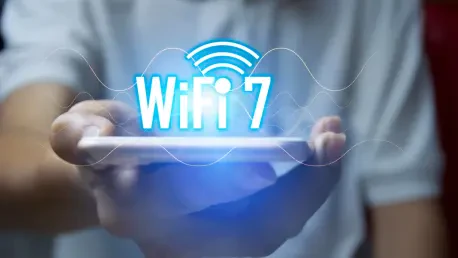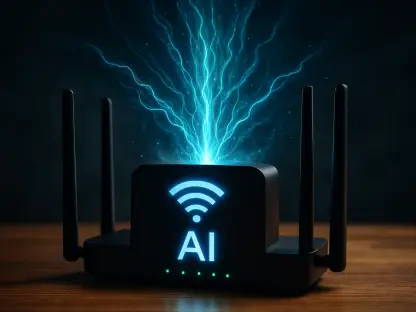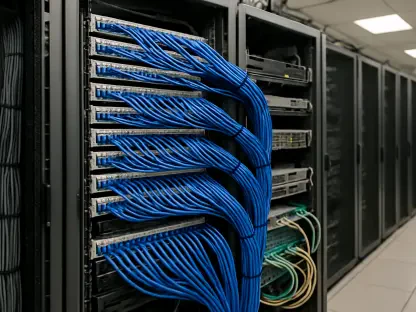With the rapid pace of technological advancements, Wi-Fi 7 is emerging as a significant player in the evolving landscape of connectivity solutions. The anticipation surrounding this next-generation wireless technology has been fueled by its promise of ultra-fast speeds, enhanced bandwidth management, and reduced latency. These features are particularly appealing for applications requiring substantial data handling, such as 8K video streaming, augmented reality (AR), and virtual reality (VR). The potential of Wi-Fi 7 extends beyond individual and corporate needs, offering transformative possibilities for the global Internet of Things (IoT) ecosystem and the burgeoning development of smart cities. As industries across the globe adapt to these advancements, questions arise about the impact of Wi-Fi 7 technology on IoT integration and urban infrastructure by the end of the decade.
Expanding IoT with Wi-Fi 7
Wi-Fi 7 is poised to revolutionize the Internet of Things, promising to address the increasing demand for high-speed wireless connectivity. In 2023, a staggering 18.8 billion IoT devices were connected worldwide, with projections indicating a jump to 40 billion by 2030. The burgeoning need for seamless connectivity calls for robust networks capable of supporting a vast range of devices simultaneously. Wi-Fi 7, with its improved multi-link operation and high-frequency bandwidth, offers these capabilities, enabling IoT systems to transmit more data at faster speeds. However, despite its promising features, the transition to Wi-Fi 7 in the IoT space faces challenges. Given the recent shift from Wi-Fi 6/6E, the full adoption of Wi-Fi 7 might take a substantial amount of time. Challenges include updating existing infrastructure, ensuring compatibility, and managing the costs of transitions for enterprises heavily invested in the current technology.
Despite these hurdles, the strategic integration of Wi-Fi 7 can profoundly reshape IoT applications in numerous sectors, from healthcare to manufacturing, by enhancing real-time communication and processing capabilities. The shift towards a more connected world underscores the necessity for a technology that can handle intense demands without compromising performance. With Wi-Fi 7, systems will efficiently manage complex IoT networks, seamlessly supporting billions of devices through superior data handling and connectivity provisions. As the IoT market continues its remarkable growth, Wi-Fi 7’s role will be pivotal in facilitating the reliable operation of diverse applications, from smart home systems to industrial automation. Its features promise not just speed and efficiency but also security advancements that could redefine IoT deployment strategies, enhancing consumer trust in a connected world.
Integrating Wi-Fi 7 in Smart Cities
The rise of smart cities represents a landmark in urban development, focusing on integrating advanced technologies to improve infrastructure and enhance the quality of life for residents. These cities rely heavily on dense network environments to manage utilities, traffic, and public services efficiently. Wi-Fi 7’s advanced capabilities position it as an ideal foundation for such digital urban transformation, given its ability to manage vast numbers of simultaneous connections alongside offering expanded band options and frequency utilization. Smart cities can leverage Wi-Fi 7 to increase the efficiency of everyday operations, from advanced traffic management systems to sophisticated environmental monitoring setups. This level of connectivity and data handling is vital as cities expand and modernize their digital infrastructure, aiming to deliver smarter, more sustainable urban living spaces.
Furthermore, the rise of Wi-Fi-as-a-Service (WaaS) models is accelerating the adoption of Wi-Fi 7 in urban centers. WaaS allows cities to outsource network management, easing the burden of deploying and maintaining complex Wi-Fi systems in public spaces. Leading vendors, including Aruba and Cisco, have already begun capitalizing on this trend, providing managed solutions that ensure cities can offer reliable, high-speed wireless access to residents and visitors alike. By enhancing connectivity, smart cities can support more robust surveillance systems, efficient energy management, and improved public transportation networks. As Wi-Fi 7 continually integrates into city infrastructure, its role in driving these advancements will likely expand, providing a seamless digital environment supporting billions of devices and reimagining urban living.
Wi-Fi 7’s Global Market Impact
The global market expectations for Wi-Fi 7 are optimistic, buoyed by predictions of it reaching substantial figures by 2030. North America currently leads this market, owing to its sophisticated technological infrastructure and insatiable appetite for fast connectivity. With the growing demands of smart cities and enterprise IoT, other regions are expected to significantly scale up their deployments, leveraging Wi-Fi 7’s advanced capabilities. Already, countries in Europe and parts of Asia are exploring opportunities to incorporate this technology into the backbone of national connectivity strategies, aligning with global trends toward modernization. The expansion is not just a race for technology but an initiative fostering global connectivity that enhances trade, communication, and development.
As Wi-Fi 7’s market share continues to grow, equal attention is given to barriers that could derail its widespread adoption. These challenges, such as high deployment costs and legacy infrastructure compatibility, require strategic planning and cooperation among policymakers, tech companies, and consumers. Despite these hurdles, the potential return on investment for businesses and governments is substantial, as Wi-Fi 7 promises to elevate efficiency and drive innovation. The trajectory is clear: as the demand for faster, more reliable connectivity grows, the operational landscape for Wi-Fi 7 will likely expand, paving the way for new business models and partnerships across various sectors as they integrate this cutting-edge technology.
Embracing Wi-Fi 7’s Potential
Wi-Fi 7 is set to transform the Internet of Things (IoT) by meeting the escalating desire for rapid wireless connectivity. In 2023, there were 18.8 billion IoT devices globally, with expectations of this number reaching 40 billion by 2030. The growing requirement for uninterrupted connectivity demands robust networks that can support numerous devices concurrently. Wi-Fi 7, with its enhanced multi-link operation and high-frequency bandwidth, addresses this by allowing IoT systems to transfer more data swiftly. However, despite its promising potential, adopting Wi-Fi 7 in the IoT realm faces hurdles. The shift from Wi-Fi 6/6E means that fully embracing Wi-Fi 7 will likely take time due to the need for infrastructure updates, compatibility assurance, and transition costs, particularly for businesses with substantial investments in current technologies. Nevertheless, integrating Wi-Fi 7 can significantly innovate IoT across sectors like healthcare and manufacturing through improved real-time communication. This transition will support complex networks, bolster security, and boost confidence in a more intricately connected world.









